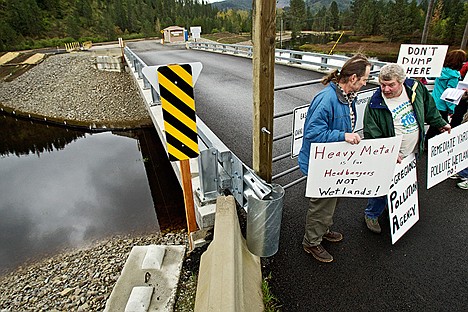Citizens protest repository site
Alecia Warren | Hagadone News Network | UPDATED 13 years, 7 months AGO
CATALDO - A sparse crowd toted signs by the East Mission Flats repository in Cataldo on Tuesday morning, with the demand to close the mining waste repository for good.
Some from grassroots environmental organizations and others just concerned citizens, the roughly 10 protesters were fearful that flooding eats away at the repository and seeps metal-contaminated soil into the adjacent Coeur d'Alene River, eventually draining into Lake Coeur d'Alene.
The citizens want the repository shut down, they said, and relocated out of the 100-year flood plain.
"I'm not opposed to the EPA. I just don't want them to give us a second-rate cleanup," said Shane Stancik, board member of the Silver Valley Community Resource Center that organized the event.
The 4-year-old repository, roughly 800 feet long and 500 feet wide, is tucked behind trees and a fenced-off road in Cataldo, just across I-90 from the Old Mission.
A repository for Superfund cleanup efforts in the lower Coeur d'Alene Basin, it now contains about 100,000 cubic yards of soil contaminated by toxic metals from past mining operations. The soil has primarily been retrieved from private yards in the Kellogg to Harrison area.
Surrounded by already contaminated wetlands, the repository is engineered to prevent erosion.
But Stancik, a lifelong Smelterville resident, believes none of the Environmental Protection Agency's efforts can protect the repository in a location prone to floods.
"It doesn't matter how well it's engineered," Stancik said. "When the river comes over the banks, it takes out anything it its wake."
Stancik, who suffers bone deterioration after exposure to lead-contaminated soil as a child, worried of a public health risk if more lead was washed out from the site.
He pointed out that last January, the U.S. Geological Survey measured 160 metric tons of lead washed downstream the Coeur d'Alene River in one day of flooding.
"I don't want my children or other people's children to pay the price with their health," he said, adding that he would prefer federal resources fund a health clinic for residents potentially exposed to the toxic metals.
Protesters mounted signs on the fence across the repository road, one reading "Egregious Pollution Agency."
Cass Davis, a Moscow resident raised in the Silver Valley, said the repository is no match for water in the flood plain.
"Water flows. It's that simple," said Davis, who brought other Moscow citizens for the protest. "I do believe (the contamination) will continue to spread."
But Don Carpenter, mine waste programscientist for the Idaho Department of Environmental Quality, assured there is quarterly ground and surface water monitoring at the site.
Visual inspections are conducted every week to detect erosion, he added.
"To date, we see no evidence of contamination leaving the site," Carpenter said. "The repository is designed to contain the contaminated waste, and it is functioning as designed."
He confirmed that 160 tons of lead were measured at the mouth of the Coeur d'Alene River last year, but that is an occurrence that precedes the repository.
"That situation's been occurring for many years. We have data dating back to '96 of lead, 122 tons a day moving through the system," Carpenter said, adding that 70 percent comes from the riverbed itself, and the rest from riverbanks and other areas. "It's a historical issue, and that's what we're trying to address with the cleanup."
The repository site was chosen for several reasons, said Ed Moreen, EPA project manager.
"Obviously serving that geographic area is a big factor, as well as access, viability of the site, knowing technical details of the site before building the facility," Moreen said. "It's something we spent many, many resources on."
Although the repository is in an area prone to occasional flooding, surrounding roads ensure that water fills the site gradually so it isn't subject to fast-moving water, according to an EPA website of frequently asked questions about the site.
Erosion controls ensure the materials aren't carried off by rain and snow, the website states.
The repository will remain at its current location permanently.
Gordon Sanders, who lives by Killarney Lake, said he attended Tuesday's protest because he is interested in the issue.
Sanders appreciates that the repository site allows for easy access, he said, and he is confident it is well fortified against flooding.
Still, he is dubious of its position across the highway from the Cataldo Mission, he said.
"It's the oldest building in Idaho, and we have this here to enhance that?" Sanders said, gesturing toward the repository signs. "I know why they chose this spot, it's easy to get to right off the highway. But the PR part was terrible."
ARTICLES BY ALECIA WARREN
Tribe's property taxes canceled
After a meeting with Coeur d'Alene Tribe officials today, Kootenai County commissioners voted unanimously to cancel all property taxes on reservation land from the past four years.
In hot water
Idaho DEQ says temps are too warm for trout
We like our fish cooked... But not before we catch them.
Past issues
Old charge blocks weapons permit
A Hayden resident believes his rights were violated when he was disqualified from obtaining a concealed weapons permit because of a felony charge from over 40 years ago.

